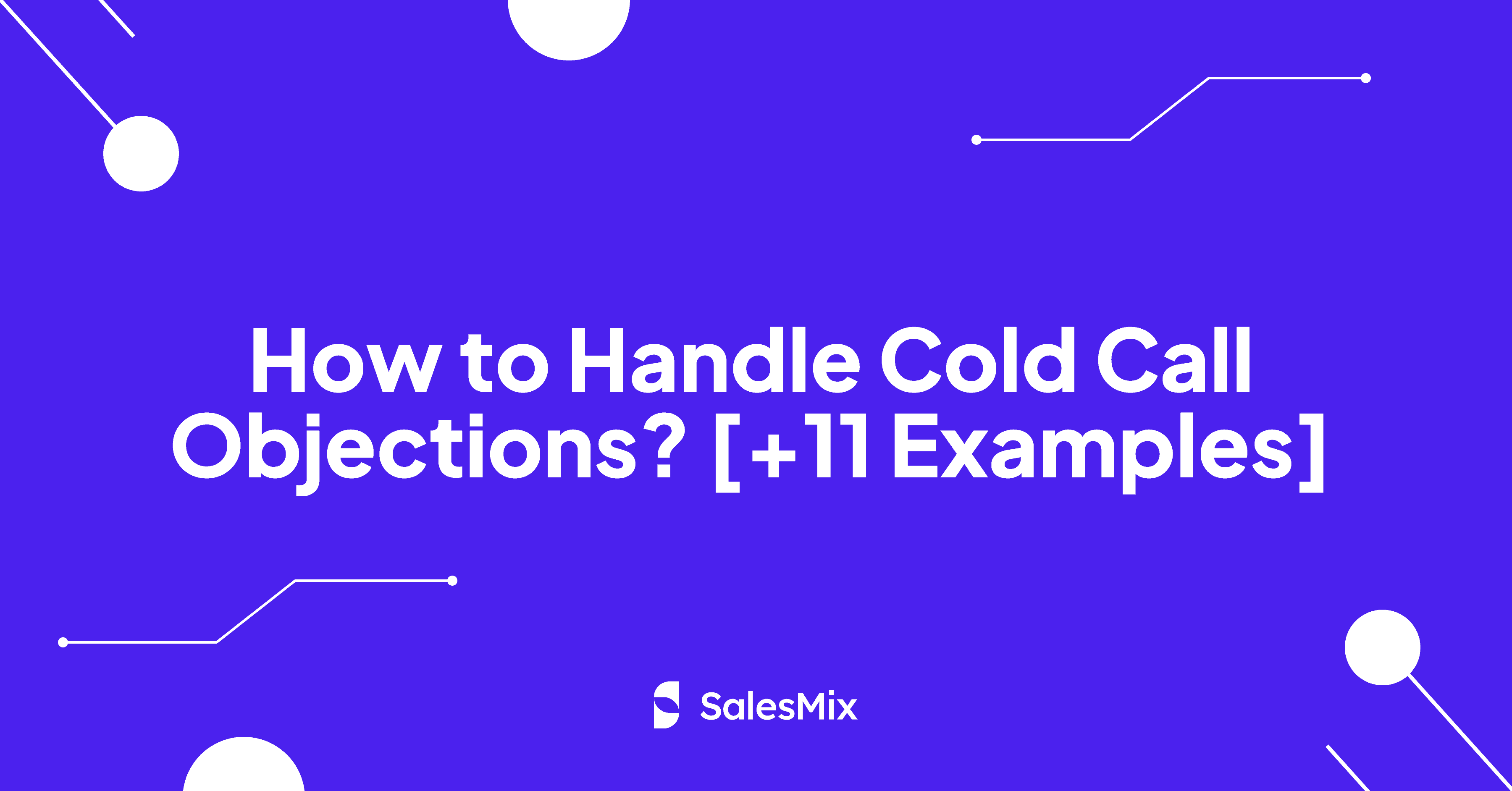Table Of Contents
Let’s face it: cold call objections are inevitable even if you make the best possible preparations for your sales call with prospects.
Whether you’re reaching out to potential clients or trying to reconnect with old ones, you’ll likely hear phrases like “I’m not interested” or “Call me back next quarter.” These responses can feel like roadblocks to any salesperson but don’t have to be deal-breakers.
With the right approach, objections can actually become opportunities to build rapport and demonstrate value. The key to handling cold call objections is actually in preparation and mindset.
In this article, we’ll look at practical approaches and provide 11 common objections in cold calls and how you can be the right person to tackle them.
Cold call objections handling
A Step-by-Step Framework to Follow to Handle Cold Call Objections
You can follow these steps to get a comprehensive guide on how you can overcome your prospects’ frictions through successful objection handling.
1. Pause When Listening to an Objection
The action you need to take here is really simple. You just need to pause for 2-3 seconds.
Why is It Necessary?
Pausing for a few seconds gives you a brief time to think and slow down before moving forward with the prospect in a hasty manner.
2. Accept and Repeat (If Needed)
You can use acknowledgment statements to reduce the tension with the prospect or a gatekeeper. The following sentences are good examples of doing so:
- I thought you might say that.
- Ouch, it must be frustrating to operate without a budget.
- I’m not surprised; [competitor to your product or service] is great.
Why is It Necessary?
Objections often trigger resistance, and responding too quickly can escalate that tension. By acknowledging and repeating the objection in a neutral or empathetic manner, you validate the prospect’s concern instead of dismissing it. This approach lowers their defences and opens the door for a more productive conversation rather than a debate or cut-off.
3. Ask for Permission or A Question (Or You May Lose the Conversation)
Depending on the directness of the objection, you can either ask for permission or a question to the prospect.
a. Ask for Permission
Before responding to the prospect, you may ask:
- Do you mind if I ask a question about that?
- Can I ask one last question?
Why is It Necessary?
When you ask for permission, you shift control to the buyer, making them feel respected rather than pressured. This small gesture builds rapport and makes the conversation feel more like a collaborative discussion. People are more open to engaging when they feel like they have a choice rather than being pushed into answering.
b. Ask a Question Right Away
When objections are very direct (e.g., “Not interested”), you should ask a question immediately to keep engaged and not lose your conversation with them.
Ask question to tackle cold call objections
Why is It Necessary?
Prospects often use quick dismissals to cut the conversation short, especially if they assume you’ll try to convince them otherwise. If you hesitate too long, they might hang up or mentally check out. Asking a well-placed question right away keeps them engaged, forces them to think beyond their automatic response, and gives you a chance to uncover their real concerns.
4. Remember That Tonality Matters
Tonality sets the mood for the conversation. A defensive or aggressive tone can make prospects feel attacked, while a calm and curious tone creates a more open and constructive discussion. People respond better when they feel heard rather than pressured. So, you should maintain a cool demeanor to increase your chances of a positive outcome.
You should avoid:
- Sarcasm
- High-pitched tone
- Annoyed or defensive responses
Your tone should be:
- Calm
- Curious
- Cool & composed
5. Post-Objection Handling
Depending on the response, you can use one of the following 3 approaches.
a. Mirroring
You can repeat the last 1-3 crucial words to encourage the prospect to open up a bit more.
Example:
Prospect: “Maybe this is not the right time.”
SDR: “Not the right time?”
b. Labeling Emotions
Using phrases like the following ones can be helpful:
- It sounds like…
- It seems like…
- It looks like…
- It feels like…
c. Dig Deeper
You should dig deeper to get more useful insight from the prospect. You can do:
- Ask follow-up questions to uncover the real pain point.
- Keep the conversation flowing instead of shutting it down.
11 Common Cold Call Objections and How to Handle Them
Let’s look at some of the common cold call objections with how you should tackle them and what you should not do. We are going to keep this very brief so that you can focus on what not to say and what to say.
1. “Call me in 6 months.”
Don’t: Sure, if this is not the right moment, I’ll call you in 6 months.
Do: Understood. May I ask, what will happen in 6 months in the business that will change the situation?
2. “There’s no budget at the moment.”
Don’t: Okay, so [desired outcome] isn’t something you see as a priority right now?
Do: Understood. If we can measure the impact the [solution] would have, could the budget constraint be reconsidered if this becomes a priority?
3. “I don’t have time now.”
Don’t: I don’t want to bother. Should I call you later on?
Do: Understood, I called out of the blue. Can I take 15 seconds to tell you why I called? If it sounds interesting, I can call you back in the afternoon.
4. “We already have an existing solution in place.”
Don’t: Let me show you how we are better than your current solution.
Do: Understood. May I ask if there’s any use case, you’d like to achieve that your current tech stack doesn’t support?
5. “We are using [competitor name].”
Don’t: Alright, but they don’t have ABC, and we are better in XYZ.
Do: Great choice, they’re really good at [topic]. Mind if I show you how we approach [topic] differently? You can decide if it aligns with your business expectations.
6. “You’re too expensive.”
Don’t: No worries, we can talk about discounts if you need them.
Do: Got it! If you don’t mind me asking, I’ve seen many different definitions of “expensive.” Can I ask what yours is? I’d love to understand the real motivation behind your statement.
7. “You’re too expensive.” (Alternative)
Don’t: If you tell me what you’re willing to pay, I can do my best to get there.
Do: Understood. Is it too expensive compared to another solution you’re considering, or do you feel I haven’t fully demonstrated the value yet?
8. “Send me an email.”
Don’t: Cool, I’ll send you an email, and we can move from there.
Do: Actually, that’s why I called. Emails often create more questions than answers. Mind if I share why I reached out in the first place? Then you can decide if it’s worth diving deeper, and I’ll be happy to send you an email.
9. “How is your company better than [competitor]?”
Don’t: We are better at A, they don’t have B, and can’t do C.
Do: They’re great, especially at A. Many companies switching from [competitor] to us love how we solve [challenges] more effectively by doing [XYZ].
10. “We don’t need it now.”
Don’t: Understood, but have you considered having [solution]?
Do: You don’t need it now? → This question helps uncover the real reason behind the objection.
11. “What’s your price?”
Don’t: I can’t tell you now because I’ll need more info for that.
Do: To give you the most precise answer, I’ll need a bit more information. But based on our conversation and my experience with similar projects, it would likely be between A and B.
Conclusion
Handling cold call objections requires preparation, emotional intelligence, and the ability to adapt on the fly. As we’ve explored in this article, objections are neither dead ends nor make you the wrong person. You should see them as opportunities to understand your prospect’s needs better and position your solution as the answer they are looking for.
So, the next time you pick up the phone, remember what you’ve learned here. Stay calm, stay curious, and most importantly, stay focused on the value proposition you are offering. You know what to do when you face the next objection in one of your cold calls with the prospect.






